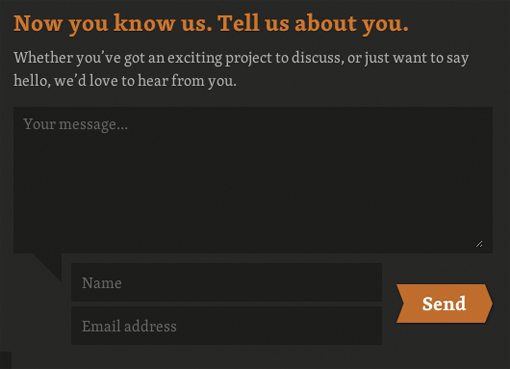The Ten Commandments of Writing Copy That Wins Clients
Web design companies and freelancers should never underestimate the power of good copy. Likewise, they should never doubt how much bad copy can hurt their chances of winning clients.
Follow along as we discuss then ten commandments of writing simple and effective copy that will convince your potential clients that you can successfully meet their needs and blow away their expectations.
More Than Design
So you’ve got yourself a gorgeous website design. You’ve spent hours making sure every pixel is perfect and you’re proud of the professional and minblowingly amazing visual aesthetic you’ve pulled off. You’re confident that when potential clients see it, they’ll be immediately convinced that you’re an A-level designer who is perfect for their projects.
Hold on though, you’re not quite finished. Selling yourself isn’t just a matter of design, you’re now faced with the task of wielding vocabulary instead of Photoshop, prose instead of CSS. When a potential client sees your site, always remember that you’ll be judged both as a person and as a designer by how you speak about yourself.
You may think you’re just a designer, but the second you start marketing yourself as a freelancer, you become both the salesman and the product. This is a place where I see new freelancers stumble time and time again. Here are ten tips to help get you on the right track.
1. Humbleness is a Virtue, But It Won’t Pay the Mortgage
One of the most prevalent mistakes that I see freelancers make is downplaying their talent, experience, or both. When a client looks at your site, you’re thrust into a sort of passive job interview and you want to make sure you put your best foot forward.
The interesting thing about hurting yourself with copy is that many freelancers don’t even realize they’re doing it. Language is a subtle art and the things that you say about yourself provide a lot more insight that you might think. Think through every sentence and how it might be perceived.
Here’s an example: When I read your bio and all you can talk about is school, I immediately think, “young and inexperienced.” Here you were giving an honest account of what currently seems important but in reality you could be scaring off clients.
Some take this much further and really cut themselves down with phrases like “still learning” or “just getting started.” The way I see it, you either can or can’t produce solid, professional work. If it’s the former, then why are you trying to scare me off with all this talk about how new you are? If it’s the latter, then why the heck would I hire you?
2. Be Honest, Just Shut Up
Now, don’t misconstrue my advice above as a suggestion to lie through your teeth about having ten years of experience and several prestigious design awards. Instead, you should be completely honest, while also being completely confident.
Think of it as an online dating profile. If you simply list all your faults, no one is going to choose you. However, if you’re untruthful and tell everyone you’re 6’6″ and have the body of a Mr. Universe candidate, they’ll immediately know you lied when you show up looking like George Costanza.
There’s a happy in-between where you stay honest and play to your strengths.
3. Be Professional
Another area where I see inexperienced freelancers fall flat on their face is in the area of professionalism. Even the most corporate of designs won’t fool anyone if you can’t live up to it with your copy.
Can you have fun graphics and still be professional? Absolutely! In fact, you can even get a little crazy with your copy and still come off as someone trustworthy and ready to take on serious design work. Here’s one example: “Kohactive is a creative digital company that produces kick-ass interactive websites…”
The tone here is both self assured and playful. It’s not for everyone but will appeal strongly to a specific market. So where do I cringe when I see professionalism abandoned?
More often than not, it’s on a freelancer’s blog, several posts of which are often shared on the homepage. I saw a freelance designer’s site the other day with a recent post discussing how his lunch made him feel sick. I’ve seen others who go into lengthy political rants. This is all well and fine, but if you want to talk about mundane life events or stand on a soap box and start wagging your finger, start a personal blog that isn’t tied to your freelance web design site.
If I stop by your site with the intention of hiring you and see posts about how you aren’t feeling well, that doesn’t inspire confidence or action in me. In fact, I’m likely to move on. Your professional blog should be about what you do: design. Write about recent projects, give tips to other designers; you can talk about yourself but keep the purpose of the blog in focus.
Keep in mind that this carries over to your Twitter stream if you’re one of the countless individuals who share recent tweets on your freelance portfolio. If you say things on Twitter that you might not want your website visitors reading (“this client is an idiot”) then it’s time to open up an account for your business and keep it separate from your personal account.
4. Say What You Do and Keep It Simple
A strong simple statement that says what you do is more important that I can possibly communicate. There are two ways you can go wrong here.
The first is to miss this step completely and get so caught up in creating an attractive and impressive website that you forget to even tell people what it is that you’re offering. Never assume visitors know anything about you or your company, make it clear exactly what it is that your business is all about.
The other way this can go is completely too far. Some freelancers and design companies write lengthy paragraphs about who they are and slap it right on the home page. Save your long speeches for the About page, this is your chance to make a strong first impression and you’ve only got about three seconds to do it.
5. Communicate Passion
Passion: this is what sells products and services. Confidence is important, but unchecked it can lead to unpleasant arrogance, instead make sure it communicates that you really care about what you do for a living.
You can see this principle at work in countless successful business men. Steve Jobs was always able to convince a room full of reporters that he had just changed the world, which he admittedly did quite a few times. However, this wasn’t always because the product was revolutionary (many were flops), it was because the man himself was obviously so excited about the product, so passionate about creating devices that people love, that you couldn’t help but get caught up in his energy.
When potential client see your site, they should get the impression that there’s nothing you’d rather do than take on their project. Good copy reels the viewer in and has them nodding all along the way. If they believe you’re really out for what’s best for them, they’ll trust you to deliver a quality project.
6. Find Your Unique Selling Proposition
This is one of the most difficult tasks on this entire list. The simple truth is that there are a million competing businesses out there. No matter who you are, you usually don’t have to look far to find someone with more talent and experience than you with a better price.
So what sets you apart? Why should someone choose you over the competition? The image above is an example of a design firm trying to answer that question. They know that you’re sick of designers who only “speak geek” and ramble on when you don’t have a clue what they’re saying. ForeFront Web promises to be different and speak in terms that you can understand.
The word “different” is powerful when used in this context. Different is a good thing when it means ease instead of frustration or unique instead of plain. Wield this word wisely.
7. Everyone Loves a Catchy Headline
Sometimes you can really nail that first impression with something simple and memorable. The site above uses the phrase “contagiously creative.” It’s an alliteration so it rolls off the tongue nicely, it speaks to what the company does and even hints at the idea of viral-style marketing that catches on and spreads quickly. That’s a lot to say in two words.
Obviously, you need more than this but starting off strong is a good way to pull people in and make them like the personality of your site and in turn your company.
8. The Proof Is In the Work
Big talk is all well and fine but ultimately visitors want to see your work to see if you can live up to your promises. Make sure first that you have great examples and that you’re showing them off front and center. Then work on some copy that makes it clear that you’re proud of this work.
The example above hits commandment five and then moves quickly into the statement, “Let our delivered projects do the rest of the talking.” This tells me that they are completely confident that once I see their work I’ll want to hire them. Setting up this expectation is a self-fulfilling prophecy that helps ensure its own success.
Obviously, if your work is crap, this technique will backfire. But that’s another article entirely.
9. It’s Not All About You
One pitfall that’s really easy to fall into, especially when creating a personal freelance website, is talking all about yourself. This is who I am, here’s what I’m good at, me me me, I I I.
A solid way to grab someone’s attention is to start talking about them. Use language that’s personal and helps communicate the idea that you’ll take the time to create a customized solution that’s perfectly tailored for their needs.
In the example above I circled the appearances of the words “you” and “your” to get you to see how much effort this copywriter put into making the copy all about the client’s needs.
10. Seal the Deal
After the client has seen your work and heard your spiel, it’s time to convince them to reach out and contact you. As a designer, you handle this by making sure your contact form is easy to find and easy to use. Many put it right on their home page.
As a copywriter, you need to write something that encourages action and effectively helps ease the tension and trepidation when it comes to taking that first step. The copy in Malaku’s form above is a great example of how to do it right. It turns the focus back to the client and lowers barriers by encouraging you to make contact regardless of whether or not you really know what you need yet. The tone is friendly and approachable and genuinely makes me want to proceed.
Conclusion
We designers are too often art nerds who think that fancy design is all you need to win clients. In truth, how you present yourself in copy is often just as important.
The next time you overhaul your freelance site, come back to this article and use the ten tips above as a checklist for writing copy that will be effective in convincing clients that they should be eager and excited to have you working as their designer.
Title Image Soure: John Taylor








